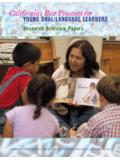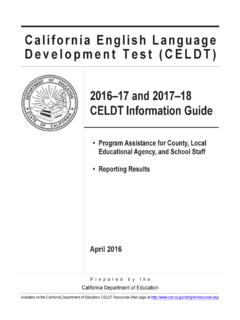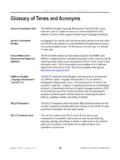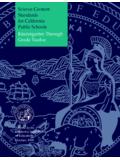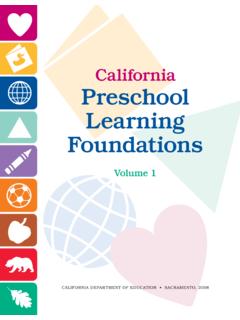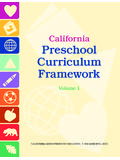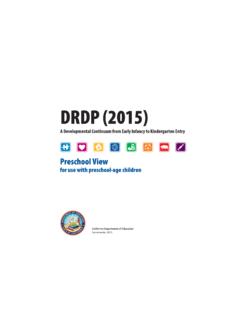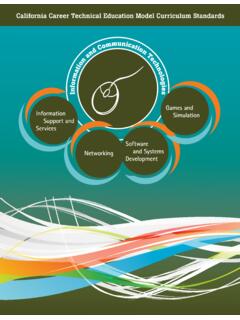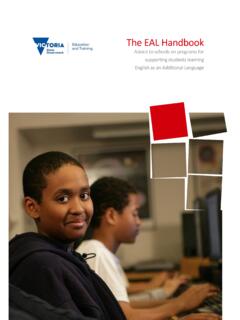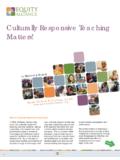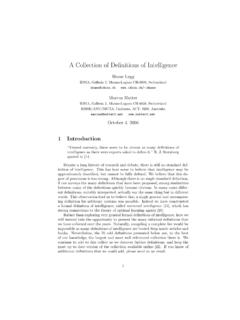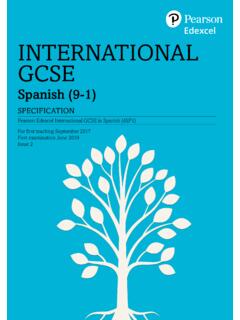Transcription of 7ORLD,ANGUAGE #ONTENT3TANDARDS FOR#ALIFORNIA 0UBLIC3CHOOLS
1 World LanguageContent Standardsfor California Public SchoolsJanuary 2009 California Department of EducationPosted September 13, 2010 World language Content Standards for California Public SchoolsKindergarten Through Grade TwelvePublishing InformationWhen the World language Content Standards for California Public Schools: Kindergarten Through Grade Twelve was adopted by the California State Board of Education on January 7, 2009, the members of the State Board were Theodore Mitchell, President; Ruth Bloom, Vice President; James Aschwanden; Alan Bersin; Yvonne Chan; Don Fisher; Gregory Jones; David Lopez; Kenneth Noonan; and Johnathan publication was edited by Faye Ong, working in cooperation with Arleen Burns, World language Consultant, and Susan Martimo, Administrator, Curriculum Frameworks Unit.
2 It was designed and prepared for printing by the staff of CDE Press, with the cover and interior design created and prepared by Cheryl McDonald. Typesetting was done by Jeannette Reyes. It was published by the California Department of Education, 1430 N Street, Sacramento, CA 95814-5901. It was distributed under the provisions of the Library Distribution Act and Government Code Section 11096. 2010 by the California Department of EducationAll rights reservedISBN 978-0-8011-1706-0 AcknowledgmentsThe State Board of Education extends its appreciation to the following individuals whose insightful comments contributed to the development and review of the standards document:Joey Baer, Lorraine D Ambruoso, David Eberwein, Iman Hashem, Sylvia Jones, Svetlana Lazarova, Norman Masuda, Rory Osbrink, Margaret Peterson, Duarte Silva, Mercedes Thompson, Marjorie Tussing, Marcia Vargas, Jose Velasquez, and Brandon commendation is extended to Yvonne Chan, State Board of Education member; Deborah V.
3 H. Sigman, Deputy Superintendent, Curriculum, Learning, and Accountability Branch; Anthony Monreal, former Deputy Superintendent, Curriculum and Instruction Branch; Phil Lafontaine, Director, English Learner and Curriculum Support Division; Thomas Adams, Director, Curriculum Frameworks and Instructional Resources Division; Marcela Obregon Enriquez, former Administrator, Curriculum Leadership Office; Susan Martimo, Administrator, Curriculum Frameworks Unit; and Arleen Burns, World language Consultant. Their significant contributions to this document deserve special InformationCopies of this publication are available for sale from the California Department of Education. For prices and ordering information, please visit the Department Web site at or call the CDE Press Sales Office at (800) 995-4099.
4 An illustrated Educational Resources Catalog describing publications, videos, and other instructional media is available from the Department Web site. NoticeThe guidance in the World language Content Standards for California Public Schools: Kindergarten Through Grade Twelve is not binding on local educational agencies or other entities. Except for the statutes, regulations, and court decisions that are referenced herein, the document is exemplary, and compliance with it is not mandatory. (See Education Code Section )iiintsConteA Message from the State Board of Education and the State Superintendent of Public Instruction ..vIntroduction ..viContent ..1 Communication ..5 Cultures.
5 7 Structures .. 9 Settings ..11 Glossary ..13 Page iv blankdo not print this instructionvA Message from the State Board of Education and the State Superintendent of Public InstructionCalifornia is home to the most diverse student population in the country, with well over a hundred languages and dialects spo-ken by children in our schools. It is important to recognize and appreciate this diversity in our schools by placing an added emphasis on the effective learning of these languages and the cultures from which they are derived. Our students need to use language effec-tively across geographic boundaries in order to cultivate positive relationships with future clients, allies, and neighbors.
6 At the same time, students also need to communicate with the diverse populations that constitute California s rich linguistic and cultural tap-estry. For this reason the standards refer to world, rather than foreign, World language Content Standards for California Public Schools, Kindergarten Through Grade Twelve sets forth for the first time a uniform vision of what students should know and be able to do in this subject area. The standards were developed to accommo-date all languages and identify the various stages of acquiring linguistic and cultural proficiency. To that end, the standards reflect our commitment to promoting excellence in world language instruction throughout the state.
7 The vision guiding these standards is that every student will develop global compe-tency in order to compete and cooperate in the twenty-first century and beyond. Given today s interconnected world, it makes good economic sense to encourage all of our stu-dents to effectively learn about the different languages and cultures of people with whom they will be interacting. Communicating with our international neighbors promotes peace-ful relations, prepares students for employ-ment, and enables our students to compete in the worldwide standards embody our collective hope that all students develop linguistic and cul-tural literacy, including academic knowledge and proficiency in English as well as in sev-eral of the world s languages and cultures.
8 In helping our students develop the skills necessary to thrive in our interdependent world, these content standards further cement California s reputation as not only a national, but an international, trendsetter in Theodore r. MiTchell President, State Board of EducationJack o connell State Superintendent of Public InstructionviIntroductionThe standards that follow are intended to provide guidance to administrators and teachers in implementing a World Languages and Cultures program for a diverse student population at any point in the curriculum from kindergarten through grade twelve. Communicative proficiency is to be developed in linguistically and culturally appropriate Global Competency To succeed in the twenty-first century, today s students need to develop academic knowledge, proficiency in English, and lin-guistic and cultural literacy in several of the world s languages and cultures.
9 The ability to communicate in culturally appropriate ways in a variety of settings will ensure success in a technologically driven global economy and increase intercultural understanding and the benefits derived from collaborative interna-tional efforts. Success in an interconnected world depends on students effective use of language and cross-cultural communication skills. As a result of culturally appropriate lan-guage use, students will enhance their ability to effectively carry out a wide range of tasks with a high level of control of the linguistic system. We can no longer afford to simply learn about languages and cultures; but rather, we must provide students with opportunities to learn languages and cultures by participat-ing in communicative interactions that prepare for real-world language use and global citizen-ship.
10 language learning needs to be a lifelong s Diverse Student PopulationCalifornia s students bring a rich variety of languages and cultures to the classroom. Stu-dents may have learned a heritage language at home, arrived recently as immigrants, or acquired the ability to understand or produce one or more languages through contact in their communities or abroad. Some students pursue languages they know; others seek opportunities to learn additional languages and cultures. Thus, the considerable number of languages spoken and taught in California schools and the range of entry points and pro-ficiency levels among students require stan-dards that are tied to student performance instead of grade level.
